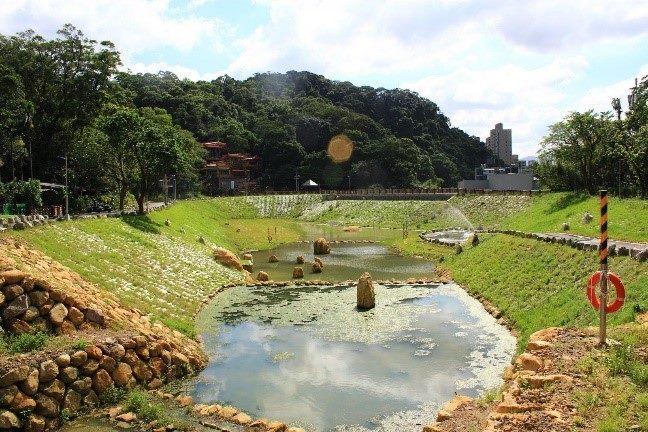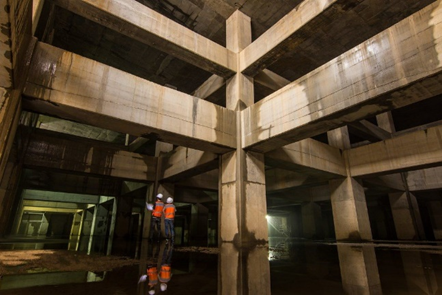As Taipei City has rapidly urbanized, much of its natural green space has been replaced by impermeable surfaces such as asphalt and concrete. This shift has significantly reduced the land’s natural ability to retain and absorb water. Coupled with the growing impacts of climate change, the city began implementing its Comprehensive Flood Management Strategy as early as 2004. This strategy introduced the concepts of “water retention upstream, flood mitigation midstream, and flood protection downstream. “By 2015, Taipei advanced this approach through the Sponge City Policy, adopting diverse methods to reduce flood risks and enhance the capacity of the overall drainage system. Measures include the use of sewer storage, detention basins, runoff control facilities across watersheds, and improvements to existing drainage infrastructure. These efforts aim to ensure that stormwater systems meet rainfall protection standards, while also promoting on-site water retention strategies that provide buffer capacity when rainfall exceeds those design limits.
To tackle the growing challenge of extreme climate events, Taipei City continues to promote policies under the Sponge City framework. This initiative builds upon the earlier midstream flood mitigation component of the Comprehensive Flood Management Strategy. However, limited open space in urban areas poses challenges when constructing retention or detention facilities. Identifying and acquiring suitable locations for such infrastructure in flood-prone catchment areas has therefore become a critical aspect of planning. To overcome these limitations, the Taipei Hydraulic Engineering Office (HEO) has explored options in suburban zones, as well as public idle land and underground areas beneath parks. These efforts aim to improve flood resilience within targeted catchments and play a vital role in ensuring long-term urban safety.
1.Dagouxi Riverside Park
In response to the extreme rainfall brought by Typhoon Winnie in 1997 and Typhoon Nari in 2001, which exceeded the capacity of the downstream stormwater drainage system and caused significant damage to lives and property in surrounding communities, Taipei City planned the construction of a detention and desilting basin. Located at the northern end of Dahu Shanzhuang Street, where Dagou River meets the underground box culvert, this facility was designed to delay floodwaters from the mountain area and intercept sediment, reducing the impact of flash floods in Neihu District.

2.Jinrui Flood Management Park
In 2006, HEO launched Phase I of the “Planning and Design of Rainwater Storage and Detention Basins in Taipei City.” The goal was to identify suitable urban sites where detention basins could be built to alleviate the pressure on downstream drainage systems during heavy rainfall. After assessing the feasibility of land acquisition, the Jinrui site was prioritized and selected for active development of a detention and desilting basin.

3.Wenshan District Detention Basins
Guided by the “midstream flood mitigation” concept, HEO began exploring detention basins as a means to store rainwater, supplemented by flow diversion measures to address capacity deficiencies caused by terrain limitations. Through coordination with the military, land at a former Military Police barracks parking lot was obtained. A detention basin was constructed underground, while the surface was developed into the Xinhai Ecological Park (No. 91 Wenmu Street) by the Public Works Department’s Parks and Street Lights Office. The Park was completed on December 31, 2020. Two additional projects were also planned to improve local drainage capacity: the “Wenshan District Xinhai Ecological Park Detention Basin” and a new detention basin north of the Wenshan Sports Center.

4.Repurposed Underground Walkway Detention Basins
Recognizing that the New Construction Office had decommissioned 21 pedestrian underpasses by sealing entrances while leaving underground spaces unused, HEO identified an opportunity to convert these structures into underground stormwater detention facilities at historically flood-prone locations. In 2020, overflow structures were installed, and in 2021, fixed pump systems were completed at the Zhongshan–Jinzhou Pedestrian Underpass Detention Basin (June 17, 2021) and the Dunhua–Nanjing Pedestrian Underpass Detention Basin (September 5, 2021), enhancing flood regulation capabilities during heavy rainfall.

5.Fulin Flood Management Park
Due to the proximity of Jiantan Mountain, the area around the Shilin Official Residence frequently experiences runoff volumes that exceed drainage system capacity during short-duration, high-intensity rainfall events. With the densely developed urban environment limiting drainage expansion, HEO has invested in a series of short-, medium-, and long-term solutions.
In 2020, a fixed pump was installed on the west side of Section 5, Zhongshan North Road, to enhance drainage capacity. In 2022, the east and west drainage systems along the same section were upgraded with one-meter-wide box culvert side ditches to increase flow capacity.
Currently, HEO is advancing the Fulin Flood Management Park Design Project, located in the green space beside Lane 100, Fulin Road. The facility will feature a two-tiered design with a total planned capacity of approximately 11,000 cubic meters. The lower basin will focus on urban flood detention and disaster mitigation, while the upper basin will serve as a landscaped detention area that reduces carbon emissions through the use of green infrastructure instead of traditional concrete. The Park will integrate flood detention, recreational space, and environmental education functions. Construction began on March 14, 2024, and is expected to be completed in 2026. Once finished, the park will enhance flood resilience in the surrounding area and provide the public with a distinctive and enjoyable place for recreation.


![Taiwan.gov.tw [ open a new window]](/images/egov.png)
